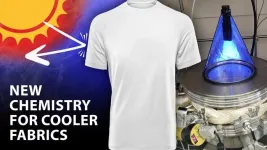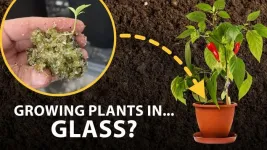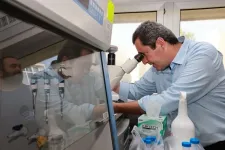Evan D. Patamia, a graduate student at the University of Massachusetts Amherst, will present their team’s results at the fall meeting of the American Chemical Society (ACS). ACS Fall 2024 is a hybrid meeting being held virtually and in person Aug. 18-22; it features about 10,000 presentations on a range of science topics.
“If you walk out into the sunlight, you will get increasingly hot because your body and clothing are absorbing ultraviolet (UV) and near-infrared (near-IR) light from the sun,” says Trisha L. Andrew, a chemist and materials scientist working with Patamia. “And as long as you’re alive, your body is generating heat, which can be thought of as light, too.”
To make people more comfortable outside, scientists have been developing textiles that simultaneously deflect the sun’s rays and push out natural body heat — a process known as radiative cooling. Some of those materials have light-refracting synthetic particles, such as titanium dioxide or aluminum oxide, embedded into spun fibers. Others use organic polymers, such as polyvinylidene difluoride, which require perfluoroalkyl and polyfluoroalkyl substances, known as PFAS or forever chemicals, in their production processes to create light-reflective textiles.
But scaling the manufacturing of these materials for commercialization isn’t sustainable, according to Andrew. So, she posed the question to research team members Patamia and Megan K. Yee, “Can we develop a textile coating that does the same thing using natural or environmentally benign materials?”
Previously, Andrew and colleagues created a simple technique to apply durable polymer coatings on fabric called chemical vapor deposition (CVD). The method combines synthesis and deposition into the same step: grafting a thin polymer layer onto commercial textiles with fewer steps and less environmental impact than other ways to attach coatings.
So, inspired by the crushed limestone-based plasters used historically to keep houses cool in extremely sunny places, Patamia and Yee worked on innovating a process to integrate calcium carbonate — the main component in limestone and chalk — as well as bio-compatible barium sulfate onto the polymer applied by CVD. Small particles of calcium carbonate are good at reflecting visible and near-IR wavelengths, and barium sulfate particles reflect UV light.
Treating small squares of fabric, the researchers applied a 5-micrometer-thick poly(2-hydroxyethyl acrylate) layer and repeatedly dipped the polymer-treated squares into solutions containing calcium or barium ions and solutions containing carbonate or sulfate ions. With each dip, the crystals become larger and more uniform, and the fabric develops a chalky, matte finish. Patamia says that by changing the number of dipping cycles, the particles can be tuned to reach the ideal size distribution (between 1 and 10 micrometers in diameter) for reflecting both UV and near-IR light.
The researchers tested the cooling abilities of treated and untreated fabrics outside on a sunny day when the temperature measured more than 90 F. They observed air temperatures underneath the treated fabric that registered 8 F cooler than the ambient temperature in the middle of the afternoon. The difference was even greater, a maximum of 15 F, between treated and untreated fabric, which heated the air underneath the sample. “We see a true cooling effect,” says Patamia. “What is underneath the sample feels colder than standing in the shade.”
As a final evaluation of the mineral-polymer coating, Yee simulated the friction and impact of laundry detergent in a washing machine. She found that the coating didn’t rub away and the material retained its cooling ability.
“So far in our processes, we’ve been limited by the size of our laboratory equipment,” says Andrew. But she’s part of a startup company that’s scaling the CVD process for bolts of fabric, which are about 5 feet wide and 100 yards long. Andrew explains that this venture could provide a way to translate Patamia and Yee’s innovations into pilot-scale production.
“What makes our technique unique is that we can do this on nearly any commercially available fabric and turn it into something that can keep people cool,” concludes Patamia. “Without any power input, we’re able to reduce how hot a person feels, which could be a valuable resource where people are struggling to stay cool in extremely hot environments.”
The research was funded by the U.S. National Science Foundation. Trisha L. Andrew is involved in commercializing the polymer coating process.
A Headline Science video about this topic will be posted on Wednesday, Aug. 21. Reporters can access the video during the embargo period, and once the embargo is lifted the same URL will allow the public to access the content. Visit the ACS Fall 2024 program to learn more about this presentation, “Functional reflective textile coatings for personal cooling,” and other science presentations.
###
The American Chemical Society (ACS) is a nonprofit organization chartered by the U.S. Congress. ACS’ mission is to advance the broader chemistry enterprise and its practitioners for the benefit of Earth and all its people. The Society is a global leader in promoting excellence in science education and providing access to chemistry-related information and research through its multiple research solutions, peer-reviewed journals, scientific conferences, eBooks and weekly news periodical Chemical & Engineering News. ACS journals are among the most cited, most trusted and most read within the scientific literature; however, ACS itself does not conduct chemical research. As a leader in scientific information solutions, its CAS division partners with global innovators to accelerate breakthroughs by curating, connecting and analyzing the world’s scientific knowledge. ACS’ main offices are in Washington, D.C., and Columbus, Ohio.
Registered journalists can subscribe to the ACS journalist news portal on EurekAlert! to access embargoed and public science press releases. For media inquiries, contact newsroom@acs.org.
Note to journalists: Please report that this research was presented at a meeting of the American Chemical Society. ACS does not conduct research, but publishes and publicizes peer-reviewed scientific studies.
Follow us: X, formerly Twitter | Facebook | LinkedIn | Instagram
Title
Functional reflective textile coatings for personal cooling
Abstract
As the effects of climate change become more severe and widespread, maintaining personal thermal homeostasis becomes both necessary for survival and increasingly energy intensive. In principle, advanced textiles and garments can leverage light absorption and/or reflection, in addition to straightforward convection, to heat or cool bodies in extreme temperature conditions. For cooling, in particular, surfaces adept at selectively reflecting or refracting high-energy wavelengths (200nm-2.5um) while transmitting or emitting infrared light (8-13um) boast the ability to maintain cooler body temperatures, even when exposed to direct sunlight and the open sky. Here, we present guiding principles for designing textiles for passive personal cooling via diffuse light reflectance. Biocompatible calcium carbonate and barium sulfate micro/nanoparticles are found to serve as appropriate optical materials for cooling via diffuse reflectance. Finite-difference time domain simulations reveal, surprisingly, that textile coatings containing a polydisperse mixture of CaCO3 and BaSO4 nano/microcrystals provide the highest, broad-spectrum reflection efficiency, as compared to extruded metamaterial fibers containing embedded particles within a polymer matrix. A stepwise process to create polydisperse CaCO3 and BaSO4 nano/microcrystal textile coatings is reported. Through the use of photoinitiated chemical vapor deposition (pICVD), a 5 um thick layer of a hydrophilic polymer polyhydroxyethyleneacrylate (pHEA) was deposited on the fabric substrate. Subsequently, through serial immersion in solutions containing Ca and Ba ions and solutions containing CO3 and SO4 ions, inorganic microcrystals were grown directly on the surface of the fabric. Upon outdoor testing, textiles coated with polydisperse CaCO3 and BaSO4 nano/microcrystals show a cooling ability of 8°C compared to an uncoated sample, achieving a maximum cooling of 4°C below ambient temperature. Washing and durability testing of the coating found no degradation in the material's performance, affirming its resilience and long-term effectiveness.
END



